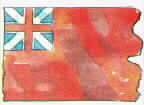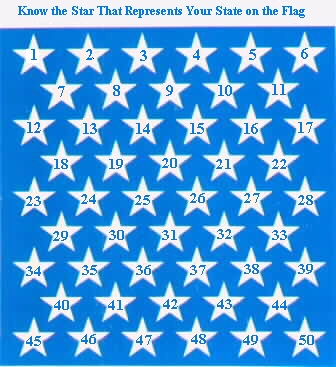
~ Old Glory ~
the flag of the United States of America
and to the Republic for which it stands,
one Nation under God,
Indivisible, with liberty and
Justice for all.
The meaning of the pledge of allegiance.
When you pledge allegiance to your flag you promise loyalty and devotion to your nation. Each word has a deep meaning.
I pledge allegiance....I promise to be true
to the flag....to the sign of our country
of the United States of America....a country made up of 50 states, each with certain rights.
and to the Republic....a country where the people elect others to make laws for them
for which it stands....the flag means the country
one Nation under God...a single country whose people believe in a supreme being
indivisible....the country cannot be split into parts
with liberty and justice....with freedom and fairness
for all....for each person in the country--you and me.
The flag of the United States of America today has 13 stripes - 7 red and 6 white - and 50 white stars on a blue field - five rows of 6 and four rows of 5. The stripes remind us of the 13 original colonies that gained us our liberty. The stars represent the states that are bound together into one country.
The flag of today grew out of many earlier flags raised in days gone by over American soil.
From the time that America was discovered, different flags flew over different parts of the country; the flags of Spain, France, Holland, Sweden, and England.
 An English flag, known as the Red Ensign, waved over the 13 colonies from 1707 to the Revolution. The Red Ensign was the merchant flag of England. It was red with a union in the upper corner combining the cross of St. George (red on white), patron of England, with the diagonal cross (white on blue) of St. Andrew, patron of Scotland.
An English flag, known as the Red Ensign, waved over the 13 colonies from 1707 to the Revolution. The Red Ensign was the merchant flag of England. It was red with a union in the upper corner combining the cross of St. George (red on white), patron of England, with the diagonal cross (white on blue) of St. Andrew, patron of Scotland. The flag that became known as the Grand Union flag was raised over George Washington's headquarters outside Boston on January 1, 1776. The Revolutionary War had started the year before and the colonies needed a flag of their own. The Grand Union flag retained the union of the English flag. Six white stripes broke the red field into seven red stripes - a total of 13 stripes.
The flag that became known as the Grand Union flag was raised over George Washington's headquarters outside Boston on January 1, 1776. The Revolutionary War had started the year before and the colonies needed a flag of their own. The Grand Union flag retained the union of the English flag. Six white stripes broke the red field into seven red stripes - a total of 13 stripes. The first official flag of the new nation was created by a resolution of the Continental Congress meeting in Philadelphia. The resolution was passed on June 14, 1777. That is the date we celebrate each year as Flag Day. The resolution specified "that the flag be 13 stripes alternate red and white; that the union be 13 stars, white in a blue field, representing a new constellation." Since the resolution did not state how the stars were to be arranged, flag makers arranged them in different ways, among them; rows, in a half circle, and in a full circle. The one adopted was made by Besty Ross and had the stars in a full circle.
The first official flag of the new nation was created by a resolution of the Continental Congress meeting in Philadelphia. The resolution was passed on June 14, 1777. That is the date we celebrate each year as Flag Day. The resolution specified "that the flag be 13 stripes alternate red and white; that the union be 13 stars, white in a blue field, representing a new constellation." Since the resolution did not state how the stars were to be arranged, flag makers arranged them in different ways, among them; rows, in a half circle, and in a full circle. The one adopted was made by Besty Ross and had the stars in a full circle. The flag that waved over Fort McHenry when it was bombarded, September 13-14, 1814, was a 15 star and 15 stripe flag. Two stripes and stars had been added to the orginal 13 on May 1, 1795. It became famous as the Star Spangled Banner. It was the flag that inspired Francis Scott Key to write our national athem.
The flag that waved over Fort McHenry when it was bombarded, September 13-14, 1814, was a 15 star and 15 stripe flag. Two stripes and stars had been added to the orginal 13 on May 1, 1795. It became famous as the Star Spangled Banner. It was the flag that inspired Francis Scott Key to write our national athem. The Flag of 1818 had the stripes reduced to 13. Five more stars had been added, for a total of 20. When still more states joined the United States, it became evident that the flag would get to be an awkward shape if more and still more stripes were added. Therefore, on April 4, 1818, Congress passed a law that restored the design back to the orginal 13 stripes. It also provided that a star be added to the blue field for each new state.
The Flag of 1818 had the stripes reduced to 13. Five more stars had been added, for a total of 20. When still more states joined the United States, it became evident that the flag would get to be an awkward shape if more and still more stripes were added. Therefore, on April 4, 1818, Congress passed a law that restored the design back to the orginal 13 stripes. It also provided that a star be added to the blue field for each new state. 
| 1. Delaware - 1787 | 26. Michigan - 1837 | 2. Pennsylvania - 1787 | 27. Florida - 1845 | 3. New Jersey - 1787 | 28. Texas - 1845 | 4. Georgia - 1788 | 29. Iowa - 1846 | 5. Connecticut - 1788 | 30. Wisconsin - 1848 | 6. Massachusetts - 1788 | 31. California - 1850 | 7. Maryland - 1788 | 32. Minnesota - 1858 | 8. South Carolina - 1788 | 33. Oregon - 1859 | 9. New Hampshire - 1788 | 34. Kansas - 1861 | 10. Virginia - 1788 | 35. West Virginia - 1863 | 11. New York - 1788 | 36. Nevada - 1864 | 12. North Carolina - 1789 | 37. Nebraska - 1867 | 13. Rhode Island - 1790 | 38. Colorado - 1876 | 14. Vermont - 1791 | 39. North Dakota - 1889 | 15. Kentucky - 1792 | 40. South Dakota - 1889 | 16. Tennessee - 1796 | 41. Montana - 1889 | 17. Ohio - 1803 | 42. Washington - 1889 | 18. Louisiana - 1812 | 43. Idaho - 1890 | 19. Indiana - 1816 | 44. Wyoming - 1890 | 20. Mississippi - 1817 | 45. Utah - 1896 | 21. Illinois - 1818 | 46. Oklahoma - 1907 | 22. Alabama - 1819 | 47. New Mexico - 1912 | 23. Maine - 1820 | 48. Arizona - 1912 | 24. Missouri - 1821 | 49. Alaska - 1959 | 25. Arkansas - 1836 | 50. Hawaii - 1959 |
Flag Etiquette
Flag Day
Holiday Index

Some of the above information was obtained from the Official Boy Scout Handbook and the United States Flag Code.